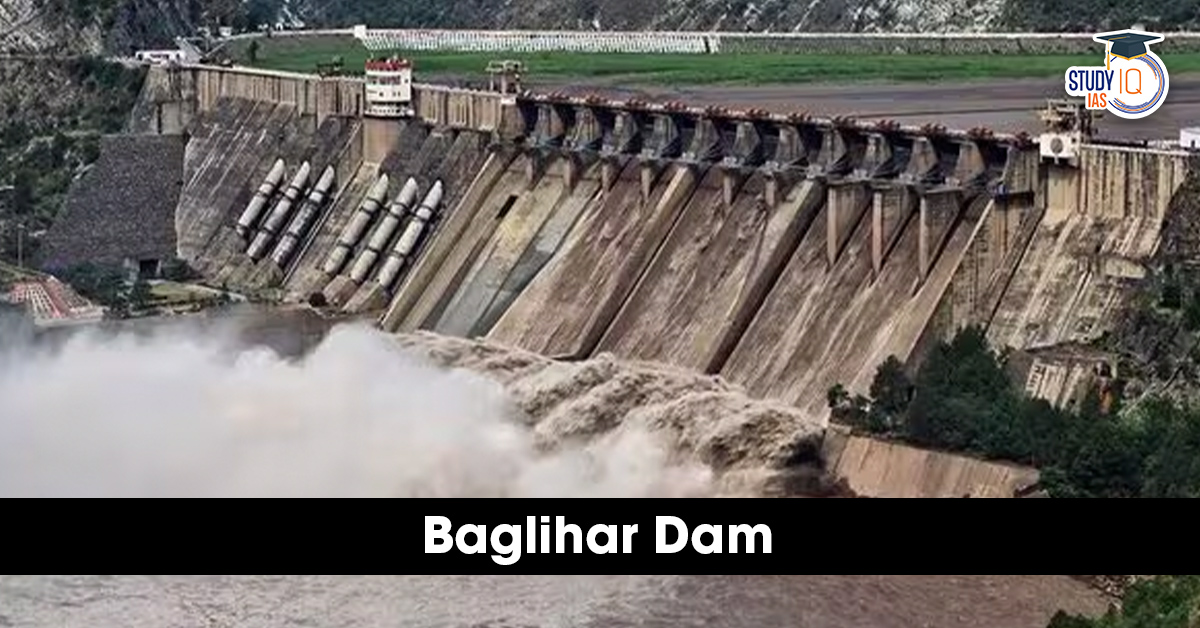Table of Contents
Baglihar Dam, or the Baglihar Hydroelectric Power Project, is one of India’s flagship hydropower projects along the Chenab River. Built in Jammu and Kashmir’s Ramban district, the dam represents India’s increasing focus on renewable energy and strategic water management under the Indus Waters Treaty (IWT).
With future mega projects such as Pakal Dul, Kiru, Kwar, and Ratle, Baglihar Dam represents India’s hydroelectric hegemony on the Chenab. While these projects are run-of-the-river in character, they are of gigantic strategic, environmental, and geopolitical importance, particularly to Pakistan.
Baglihar Dam
The Baglihar Dam, situated on the Chenab River in Jammu and Kashmir’s Ramban District, is India’s vital hydroelectric project for energy production. The project is officially called the Baglihar Hydroelectric Power Project and will use the energy of the Chenab River to produce electricity for the country, increasing India’s energy output while negotiating difficult water-sharing treaties with Pakistan.
| Feature | Details |
|---|---|
| Location | Ramban District, Jammu and Kashmir, India |
| River | Chenab River |
| Type | Run-of-the-river hydropower project |
| Total Installed Capacity | 900 MW (450 MW in Phase I, 450 MW in Phase II) |
| Height of Dam | 143 meters |
| Length of Dam | 317 meters |
| Commissioned | Phase I in 2008, Phase II in 2016 |
| Operational Agency | Jammu and Kashmir Power Development Corporation (JKPDC) |
The dam’s run-of-the-river design means it does not store large amounts of water but uses the natural flow of the river to generate electricity. The project’s primary purpose is to produce hydropower while ensuring minimal disruption to the downstream flow, which is crucial for agricultural activities in Pakistan.
The Hydroelectric Power Project: Phases of Construction
The Baglihar Hydroelectric Power Project was developed in two phases:
-
Phase I (1999–2008): This phase added 450 MW to the grid and laid the groundwork for subsequent phases.
-
Phase II (2009–2016): This phase completed the project, adding an additional 450 MW, bringing the total capacity to 900 MW.
The dam’s power generation relies on the natural flow of the Chenab River, and it operates efficiently without the need for large water storage. This makes it a vital part of India’s renewable energy initiatives.
The Indus Waters Treaty and Baglihar Dam
The Indus Waters Treaty, signed between India and Pakistan in 1960, allocates control over the Indus and its five tributaries. While Pakistan has exclusive rights to the Jhelum, Chenab, and Indus rivers, India is allowed to use them for non-consumptive purposes, such as hydroelectric generation. However, the dam designs must ensure that India doesn’t reduce the downstream water flow to Pakistan during critical agricultural seasons.
Baglihar Dam has been at the heart of this dispute due to Pakistan’s concerns about the dam’s design, particularly the height of its spillways and the water storage capacity. Pakistan claimed that the dam’s construction violated the treaty and could lead to water scarcity in its territories. However, after the World Bank-appointed neutral expert ruled in favor of India in 2007, it was confirmed that the dam’s construction met treaty provisions with minor design modifications.
Major Dams on the Chenab River – Key Projects in India
| Project Name | Location | Capacity | Status | Significance |
|---|---|---|---|---|
| Salal Hydroelectric Project | Reasi District, J&K | 690 MW | Commissioned in 1987 | One of India’s earliest hydropower projects on the Chenab; supplies power to J&K. |
| Pakal Dul Hydroelectric Project | Doda District, J&K | 1,000 MW | Under construction (2025) | Will be one of India’s largest hydropower plants; boosts J&K’s power capacity. |
| Ratle Hydroelectric Project | Kishtwar District, J&K | 850 MW | Under construction | Strengthens India’s energy infrastructure; supports the northern power grid. |
| Kiru Hydroelectric Project | Kishtwar District, J&K | 624 MW | Under construction | Part of India’s strategic plan to harness the Chenab’s hydropower potential. |
Impact on Pakistan and Regional Tensions
Pakistan’s objections to these dams have been ongoing. It cites possible adverse effects on water supplies in its Punjab province, which is heavily reliant on the Chenab River for farming. The cut in water supply, especially during the Rabi season, would impact Pakistan’s capacity to irrigate its fields, resulting in possible crop failures and food shortages.
Despite these issues, India has pledged to ensure that its hydropower projects do not breach the Indus Waters Treaty. However, the Chenab dams are still a contentious issue in India-Pakistan relations and have implications for wider South Asian geopolitics.
Conclusion: The Future of Hydroelectric Projects on the Chenab River
The Baglihar Hydroelectric Power Project, along with its appurtenant dam,s is a noteworthy achievement in the hydropower infrastructure of India, advancing India’s energy security, water control, and the economic development of the region. Yet, while India continues onward with other schemes on the Chenab River, the geopolitical issue, especially that with Pakistan, will continue to be a sensitive point.
India’s emphasis on water management and clean energy must remain in keeping with the twin challenges of serving its requirements for sustainable development alongside the demands of its neighbours through the Indus Waters Treaty. With additional projects such as Ratle, Kiru, and Pakal Dul coming online, their contribution to cross-border sharing of waters and regional security will become all the more acute.


 Places in News for UPSC 2025 for Prelims...
Places in News for UPSC 2025 for Prelims...
 Iron Ore, Types, Uses, Distribution in I...
Iron Ore, Types, Uses, Distribution in I...
 Low Pressure System and Madden-Julian Os...
Low Pressure System and Madden-Julian Os...





















